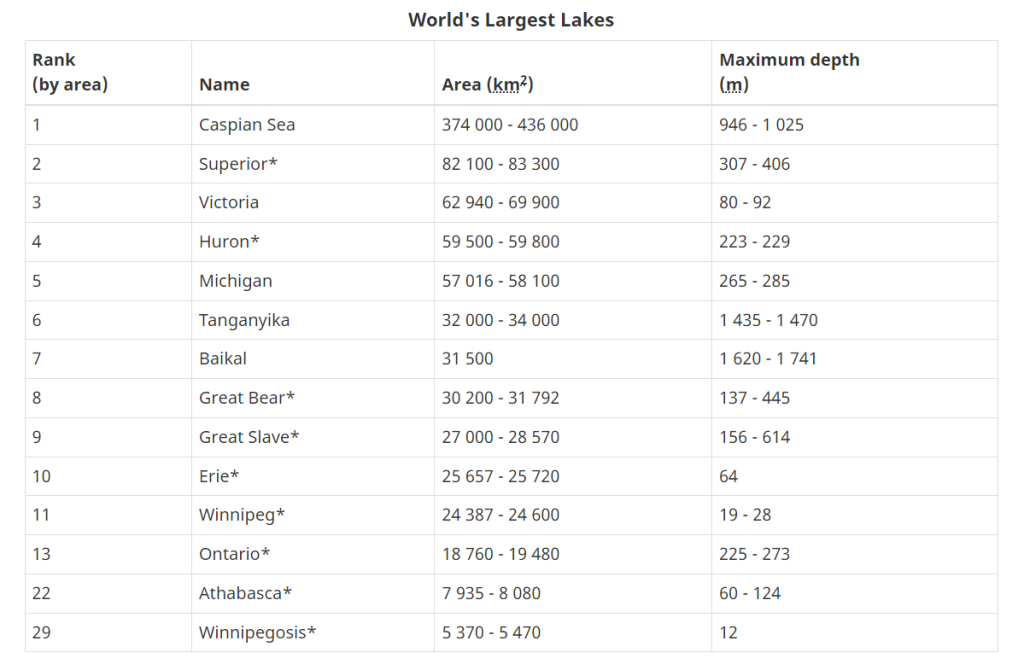Did you know that Canada has more than half of the world’s lakes? There are over 3 million lakes worldwide, with 60% of these lakes located in Canada. The lakes are so numerous that they account for around 7.6% of the country’s area. The country’s deepest lake, at 614 meters, is Great Slave Lake.
A lake is a large body of water surrounded by land and supplied with water by rivers, springs, or local precipitation.
Canadian lakes, which number in the hundreds, are a source of incredible natural beauty. Apart from their aesthetic value, lakes provide a plethora of functional benefits. Much of the water we use for home, agricultural, and industrial purposes comes from surface water, much of which is held in lakes. Additionally, lakes supply us with modes of transportation, recreational possibilities, biodiversity hotspots, and natural ecosystems.
Certain land use practices and other human activities have jeopardized the health of several of our lakes, including the Great Lakes, the world’s biggest freshwater system.
The Government of Canada’s Action Plan for Clean Water is protecting and restoring critical regions, including Lake Simcoe, Lake Winnipeg, and Great Lakes Areas of Concern.
Does Canada have the most lakes in the world?
Yes, Canada has the most lakes in the world, yet little is known about them.
Bernhard Lehner, associate professor of geography at McGill University, determined to modify that. He created a new worldwide database to aid scientists studying the significance of lakes in Earth’s ecosystem.
According to canada.ca, Canada has 9 out of 30 largest lakes in the world.

While we frequently concentrate on the ocean’s lifecycle and the critical role it plays on a global scale, the world’s more than a million lakes are also impacted by — and may influence — weather patterns, ecology, and even climate.
While scientists have a variety of technologies at their disposal to investigate lakes and rivers, including satellites, they cannot see very deep beyond the surface. Indeed, scientists have been able to correctly classify just around a hundred lakes.
Lehner, the database’s senior contributor, calculated the depth and water capacity of the world’s 1.42 million lakes. The study concentrated on those of at least ten hectares in size. And Canada is home to a staggering 62% of them.
The importance of the role in Canada’s environment cannot be overstated, he added.
“You have to understand how critical they are to the entire water cycle,” Lehner added. “There is, in fact, no water cycle in Canada without them.”
And, with so many lakes in Canada, we really need to take stock and pay them more care, he added.
“What if they begin to vanish? What ecosystems would be lost if they left? How do they affect the weather and climate? Acquainting itself with them is one of the things Canada should undertake.”
Additionally, lakes can be significantly impacted by a changing climate. The future of the north, which contains the majority of Canada’s lakes, is uncertain: as the permafrost melts, we risk losing lakes as they drain into the earth. However, new lakes may arise.
How old are the Canadian lakes?
Another aspect of the investigation was determining the duration of the water in the lakes.
For example, the water in Ontario’s Lake Superior lasts around 130 years. Water in the Northwest Territories’ Great Bear Lake has a similar duration, between 120 and 130 years.
World map of lakes with a surface area of at least ten hectares. Canada’s big, dark blue areas represent the region’s great number of lakes. (McGill University’s HydroLAB)
This new knowledge assists scientists in determining how that water may interact with the surrounding environment and life. For instance, if a lake becomes very contaminated or if a large amount of silt flows into it, researchers will now have a better notion of the consequences.
Lehner thinks that this new information will contribute to further research and understanding of the world’s lakes.



